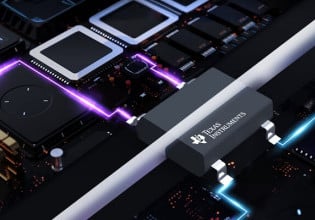1.2kW GaN FET Half-Bridge Synchronous Buck or Boost Evaluation Board
The TDHBG1200DC100 half-bridge evaluation board from Transphorm provides the elements of a simple buck or boost converter, using the Transphorm daughter card TDHB-65H070L-DC for basic study of switching characteristics and efficiency achievable with Transphorm's 650V Gallium-Nitride FETs in the standard 8x8 PQFN package. In either buck or boost mode the circuit can be configured for synchronous rectification.
Jumpers allow use of a single logic input or separate hi/lo inputs. The high-voltage input and output can operate at up to 400Vdc, with a power output of up to 1.2kW. The inductor provided is intended for efficient operation at 100kHz, although other inductors and other frequencies may be easily used.
The circuit comprises a simple half-bridge featuring 1 TP65H070LDG and 1 TP65H070LSG GaN FETs, as indicated in the block diagram below.
 Functional block diagram (click on image to enlarge)
Functional block diagram (click on image to enlarge)
Two high-voltage ports are provided which can serve as either input or output, depending on the configuration—boost or buck. In either case one FET acts as the active power switch while the other carries the freewheeling current. The latter device may be enhanced, as a synchronous rectifier, or not. With GaN FETs the reverse recovery charge is low and there is no need for additional freewheeling diodes.
Two input connectors are provided which can be connected to sources of logic-level command signals for the hi/lo gate driver. Both inputs may be driven by off-board signal sources; or alternatively, a single signal source may be connected to an on-board pulse-generator circuit which generates the two non-overlapping pulses. Jumpers determine how the input signals are used.
An inductor is provided as a starting point for investigation. This is a 440µH toroid intended to demonstrate a reasonable compromise between size and efficiency for power up to 1.2kW at a switching frequency of 100kHz.
The mother board and daughter card can be used for evaluation of basic switching functionality in a variety of circuit configurations. It is not a complete circuit, but rather a building block. It can be used in steady-state dc-dc converter mode with output power up to 1.2kW.
When operating the board at high power (>500W), an external fan should be used to cool the heatsink on the daughtercard.






